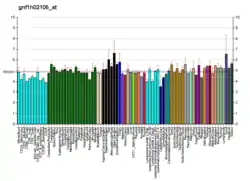OR5A1
Olfactory receptor 5A1 is a protein that in humans is encoded by the OR5A1 gene.[5]
| OR5A1 | |||||||||||||||||||||||||||||||||||||||||||||||||||
|---|---|---|---|---|---|---|---|---|---|---|---|---|---|---|---|---|---|---|---|---|---|---|---|---|---|---|---|---|---|---|---|---|---|---|---|---|---|---|---|---|---|---|---|---|---|---|---|---|---|---|---|
| Identifiers | |||||||||||||||||||||||||||||||||||||||||||||||||||
| Aliases | OR5A1, OR11-249, OR5A1P, OST181, olfactory receptor family 5 subfamily A member 1 | ||||||||||||||||||||||||||||||||||||||||||||||||||
| External IDs | MGI: 2153205 HomoloGene: 17342 GeneCards: OR5A1 | ||||||||||||||||||||||||||||||||||||||||||||||||||
| |||||||||||||||||||||||||||||||||||||||||||||||||||
| |||||||||||||||||||||||||||||||||||||||||||||||||||
| |||||||||||||||||||||||||||||||||||||||||||||||||||
| |||||||||||||||||||||||||||||||||||||||||||||||||||
| |||||||||||||||||||||||||||||||||||||||||||||||||||
| Wikidata | |||||||||||||||||||||||||||||||||||||||||||||||||||
| |||||||||||||||||||||||||||||||||||||||||||||||||||
Olfactory receptors interact with odorant molecules in the nose, to initiate a neuronal response that triggers the perception of a smell. The olfactory receptor proteins are members of a large family of G-protein-coupled receptors (GPCR) arising from single coding-exon genes. Olfactory receptors share a 7-transmembrane domain structure with many neurotransmitter and hormone receptors and are responsible for the recognition and G protein-mediated transduction of odorant signals. The olfactory receptor gene family is the largest in the genome. The nomenclature assigned to the olfactory receptor genes and proteins for this organism is independent of other organisms.[5]
Genetic differences
A single-nucleotide polymorphism in the OR5A1 receptor (rs6591536[6]) causes very significant differences in the odor perception of beta-ionone, both in sensitivity and also in subjective quality. Individuals who contain at least one G allele are sensitive to beta-ionone and perceive a pleasant floral scent, while individuals who are homozygous AA are ~100 times less sensitive and at higher concentrations perceive a pungent sour/vinegar odor instead.[7]
See also
References
- GRCh38: Ensembl release 89: ENSG00000172320 - Ensembl, May 2017
- GRCm38: Ensembl release 89: ENSMUSG00000067522 - Ensembl, May 2017
- "Human PubMed Reference:". National Center for Biotechnology Information, U.S. National Library of Medicine.
- "Mouse PubMed Reference:". National Center for Biotechnology Information, U.S. National Library of Medicine.
- "Entrez Gene: OR5A1 olfactory receptor, family 5, subfamily A, member 1".
- "rs6591536". SNPedia.
- Jaeger SR, McRae JF, Bava CM, Beresford MK, Hunter D, Jia Y, Chheang SL, Jin D, Peng M, Gamble JC, Atkinson KR, Axten LG, Paisley AG, Tooman L, Pineau B, Rouse SA, Newcomb RD (2013). "A Mendelian Trait for Olfactory Sensitivity Affects Odor Experience and Food Selection". Current Biology. 23 (16): 1601–1605. doi:10.1016/j.cub.2013.07.030. PMID 23910657.
Further reading
- Fuchs T, Malecova B, Linhart C, et al. (2003). "DEFOG: a practical scheme for deciphering families of genes". Genomics. 80 (3): 295–302. doi:10.1006/geno.2002.6830. PMID 12213199.
- Malnic B, Godfrey PA, Buck LB (2004). "The human olfactory receptor gene family". Proc. Natl. Acad. Sci. U.S.A. 101 (8): 2584–9. Bibcode:2004PNAS..101.2584M. doi:10.1073/pnas.0307882100. PMC 356993. PMID 14983052.
External links
- OR5A1+protein,+human at the U.S. National Library of Medicine Medical Subject Headings (MeSH)
This article incorporates text from the United States National Library of Medicine, which is in the public domain.




